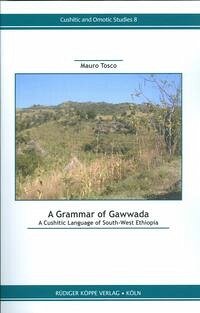Gawwada is a member of the so-called Dullay dialect cluster and is spoken in South-West Ethiopia (administratively, a part of the “Southern Peoples, Nations, and Nationalities Regional State;” SPNNR). Within Dullay a Western and an Eastern group of dialects can be opposed; the former is basically made up of Ts’amakko (ISO 639-3 tsb) and Gawwada, and, geographically, spans the two banks of the Weyt’o river; the Eastern dialects occupy the highlands to the east and north of Gawwada; Harso, Dobaze, and the other dialects (grouped under Gawwada in ISO 639-3) are representative of the Eastern group. Dullay has gained wider acceptance in the linguistic literature and will be retained here, although it must be stressed that none of these denominations bears any meaning to the speakers themselves. In this book, Gawwada is used as the dialect spoken in the town of Gawwada and in the neighboring villages. The village lies at an approximate elevation of 1,650 meters; its approximate location is 5°25’ N, 37°14’ E, around 40 km westwards of Konso, and a dozen kilometers north of the main road leading from Konso to Jinka and the Omo valley. In Ethiopia, Gawwada was until recently used as a cover term for all the Dullay-speaking groups except the Ts’amakko, who live on the western bank of the Weyt’o river. Although linguistically unwarranted, the division of the Dullay-speakers between Gawwada and Ts’amakko division reflects well the cultural and economic cleavage between the inhabitants of the highlands, with their economy centered around agriculture, and the Ts’amakko, pastoralists and political allies of the Omotic Hamar and Banna, from whom they have been heavily influenced culturally. The Dullay dialects are not endangered. Bi- and multilingualism involves first of all Amharic, then Konso and other Konsoid varieties. The Dullay dialects are not usually written. A dictionary of Gawwada has been published with us by the same author (ISBN 978-3-89645-494-2).
Bitte wählen Sie Ihr Anliegen aus.
Rechnungen
Retourenschein anfordern
Bestellstatus
Storno

